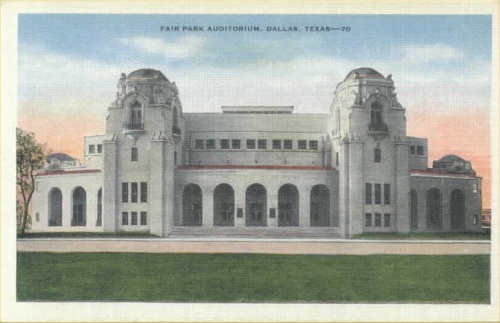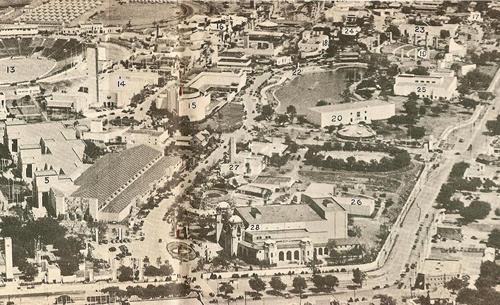|
Behind
the Sydney
Smith Memorial Fountain, Music Hall stands on the previous site
of Cycle Park. Charles McAdams built the park in 1896 as a
place where people could enjoy the leisure activity of biking. He
soon added a steep, wooden racetrack for bicycle races and some bleachers.
Calling it the the Cycle Park Theater, Charles became the manager.
The attraction later became a place to host outdoor festivals, plays,
and concerts. A large fire burned it to the ground in 1903 and a new
structure was built.
During the theater's tenure, the surrounding park had its name changed
to Gaston Park, honoring the local banker responsible for providing
the fairground acreage. Although William Gaston managed to get the
thirteen-and-a-half acres of land for 96,000 dollars, the city government
couldn't do anything with the park because the Dallas Baseball Club
had leased the area earlier. The leaders got together and convinced
the organization to sell its contracts for 12,000 dollars in 1914.
The land was used for state fair expansion the following year.
|
 |
Fair
Park Auditorium
Postcard courtesy www.rootsweb.com/ %7Etxpstcrd/ |
Fair Park
Auditorium, as it was originally called, took 500,000 dollars
to build. The architectural firm Lang and Witchell completed the project
in 1925. Erected on the site of the Cycle Park Theater, Music Hall
introduced the citizens of Dallas to Broadway
musicals. The first production performed at the venue, however, was
not the one originally planned. Management wanted to show Sky High,
an adaptation of the British-based musical farce called Whirled
into Happiness. It tells the story of a mistaken identity that
results in the main character falling in love with a woman with the
two of them having a happy ending, despite a series of complicated
events and circumstances. Unfortunately for those hoping to see the
Sky High production, conflicts with musician unions arose, resulting
in the show being canceled.
Management looked around and ultimately chose a Broadway musical called
The Student Prince. Written by Dorothy Donnelley and composed
by Sigmund Romberg, the story is based upon Wilhelm Meyer-Forster's
theatrical play Old Heidelberg. The musical version covers
a prince who is weary of his life as a member of royalty and sets
off to a faraway land. He falls in love with a young woman, but circumstances
arise that forces him to go back. He eventually returns only to find
out they can never be together. Despite the unhappy ending, the production
became an instant success when it debuted on Broadway in 1924. In
fact, it surpassed Show Boat in terms of longevity at the New
York City venue with 608 performances. The popular musical then went
on a musical tour throughout the nation, which involved a stop in
Dallas at Fair Park's Music Hall. |
 |
During
the centennial celebration,
the building became an exhibit hall for General Motors. The
following year saw its transformation into a casino for the Pan Am
Expo. From 1957 to 2009, it served as the home of the Dallas Opera
in addition to performances by visiting musical productions, theatrical
companies, ballet tours, and the Dallas Symphonic Orchestra. Out of
all the performing arts venues that have appeared at Music Hall, the
most famous one is the Summer Dallas Musicals program.
The program began in 1941 with a completely different name and location.
Taking place at the Fair Park Bandshell, it was called Opera Under
the Stars. Funds to produce the first season came from a group of
local businesses and a New York City company called the Schubert Organization.
Blossom Time, a British musical about composer Franz Schubert,
served as the first production on the outdoor stage. The only reason
why the the event took place at the band shell instead of Music Hall
was the fact that the building had no air-conditioning. Despite the
high temperatures and plentiful rain, the first run made a profit
large enough to warrant another season. Unfortunately, the bombing
of Pearl harbor and the proceeding war against the Japanese ended
plans for a summer entertainment program for 1942.
A non-profit organization was established the following year by a
group of businessmen. Wanting to establish the tradition of providing
outdoor entertainment during the summer, the members produced a series
of ten shows under the name Starlight Operettas. The organization,
however, was not completely independent because the program took place
inside Fair Park, which meant that the State Fair Association had
the power to make decisions. The SFA did so in 1944 when it appointed
Charles R. Meeker, Jr. to be the first executive director of Starlight
Operettas.
Originally from West Virginia, Charles moved to Texas so he could
attend Southern Methodist University to study journalism. He graduated
with the degree but ended up working for Interstate Theaters, a company
that specialized in running vaudeville establishments. From there,
he moved upward and gained the attention of the SFA when its members
began their search for a leader. Meeker took over in 1945 and worked
hard to make the summer program a large success. He made physical
changed to the bandshell to make things easier for the visiting productions
and focused on booking the popular musicals of the time. In addition,
he began the practice of increasing attendance by the use of star
power. Meeker managed to get famous singers like Mary Martin, Vivienne
Segal, Jack Benny, Judy Garland, and Debbie Reynolds. |
 |
Music Hall
October, 2009 photo courtesy Andreas Praefcke* |
|
Music Hall
finally received its air-conditioning in 1951, prompting Starlight
Operettas to move into the building and change its name to State
Fair Musicals. Meeker left Dallas in
1961 for a musical director position at Six Flags Over Texas. Tom
Hughes, the house manager, took his place the following year. Under
his watch, the program became an organization independent form the
state fair. It was also renamed Dallas Summer Musicals. The DSM
continued to grow in popularity and reputation during Tom's tenure.
When he passed away in 1994, Michael Jenkins took over the reigns.
Jenkins started his musical career as an usher at Music Hall and
became one of Meeker's assistants. He went with Meeker to Six Flags
and eventually became the park's vice-president. Jenkins was running
his own theme park company when he received an offer to run Dallas
Summer Musicals. He accepted the offer and still serves as the executive
director. He is also the president of Music Hall.
Currently
capable of seating 3,420 guests, the Music Hall is modeled to reflect
the styles of Spanish colonialism with hints of Moorish design.
There six stair towers, each with a dome on top. In addition, there
are several porches that have arches positioned over them. The first
major change came with the aforementioned addition of air-conditioning
in 1951. The building then experienced a large remodeling project
in in 1972. It increased the size of the backstage area, improved
the auditorium acoustics, installed more comfortable seats, expanded
the lobby, provided enough space for an indoor box office, and added
the Crystal Terrace Restaurant. Music Hall remained the same for
twenty-seven year until it underwent some changes in 1999. The job
included better acoustics, new carpeting, new paint, refurbished
chairs, along with the addition of a guest relations center and
gift shop.
*Author's
Note:
All the pictures that are not mine are either public domain or creative
commons. I provided the photographer's name.
|
References:
1.Bigtex.com
2.Dallashistory.org
3.Dallas Morning News Archives
4.Fairpark.org
5.Slate, John H. Historic Dallas Parks. Arcadia Publishing, 2010.
6.Tshaonline.org
7.Watermelon-kid.com
8.Wikipedia.org
8.Winters, Willis Cecil. Fair Park. Arcadia Publishing, 2010. |
|
|
| Texas
Escapes, in its purpose to preserve historic, endangered and vanishing
Texas, asks that anyone wishing to share their local history, stories,
landmarks and vintage or recent photos, please contact
us. |
|
|
